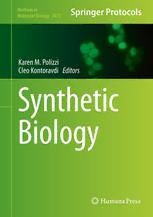
Synthetic Biology PDF
Preview Synthetic Biology
Methods in Molecular Biology 1073 Karen M. Polizzi Cleo Kontoravdi Editors Synthetic Biology M M B TM ETHODS IN OLECULAR IOLOGY SeriesEditor JohnM.Walker School ofLife Sciences University ofHertfordshire Hatfield, Hertfordshire,AL109AB,UK For further volumes: http://www.springer.com/series/7651 . Synthetic Biology Edited by Karen M. Polizzi Centre for Synthetic Biology and Innovation, Department of Life Sciences, Imperial College London, London, UK Cleo Kontoravdi Centre for Process Systems Engineering, Department of Chemical Engineering, Imperial College London, London, UK Editors KarenM.Polizzi CleoKontoravdi CentreforSyntheticBiologyandInnovation CentreforProcessSystemsEngineering DepartmentofLifeSciences DepartmentofChemicalEngineering ImperialCollegeLondon,London,UK ImperialCollegeLondon,London,UK ISSN1064-3745 ISSN1940-6029(electronic) ISBN978-1-62703-624-5 ISBN978-1-62703-625-2(eBook) DOI10.1007/978-1-62703-625-2 SpringerNewYorkHeidelbergDordrechtLondon LibraryofCongressControlNumber:2013945303 ©SpringerScience+BusinessMediaNewYork2013 Thisworkissubjecttocopyright.AllrightsarereservedbythePublisher,whetherthewholeorpartofthematerialis concerned,specificallytherightsoftranslation,reprinting,reuseofillustrations,recitation,broadcasting,reproduction onmicrofilmsorinanyotherphysicalway,andtransmissionorinformationstorageandretrieval,electronicadaptation, computersoftware,orbysimilarordissimilarmethodologynowknownorhereafterdeveloped.Exemptedfromthis legalreservationarebriefexcerptsinconnectionwithreviewsorscholarlyanalysisormaterialsuppliedspecificallyfor thepurposeofbeingenteredandexecutedonacomputersystem,forexclusiveusebythepurchaserofthework. DuplicationofthispublicationorpartsthereofispermittedonlyundertheprovisionsoftheCopyrightLawofthe Publisher’slocation,initscurrentversion,andpermissionforusemustalwaysbeobtainedfromSpringer.Permissions forusemaybeobtainedthroughRightsLinkattheCopyrightClearanceCenter.Violationsareliabletoprosecution undertherespectiveCopyrightLaw. Theuseofgeneraldescriptivenames,registerednames,trademarks,servicemarks,etc.inthispublicationdoesnot imply,evenintheabsenceofaspecificstatement,thatsuchnamesareexemptfromtherelevantprotectivelawsand regulationsandthereforefreeforgeneraluse. Whiletheadviceandinformationinthisbookarebelievedtobetrueandaccurateatthedateofpublication,neitherthe authorsnortheeditorsnorthepublishercanacceptanylegalresponsibilityforanyerrorsoromissionsthatmaybe made.Thepublishermakesnowarranty,expressorimplied,withrespecttothematerialcontainedherein. Printedonacid-freepaper HumanaPressisabrandofSpringer SpringerispartofSpringerScience+BusinessMedia(www.springer.com) Preface SyntheticBiologyutilizesthedesignandconstructionprinciplesofengineeringtodevelop newbiologicalcomponentsandsystemsorembednovelfunctionsintoexistingones,and standardize their behavior. This systematic approach to improving and increasing the programmabilityandrobustnessofbiologicalcomponentsisexpectedtoleadtothefacile assemblyofartificialbiological components and integratedsystems.While therehas been considerable success in the field, it is still far from its full potential, with major challenges including standardization of parts so that they function reliably, with functional stability in face of mutations and other biophysical constraints such as noise, and integration of differentparts. The ambitious goals and interdisciplinary nature of this new research field have prompted the advancement of molecular biology techniques to meet the need for rapid development of biological building blocks as well as for their functional characterization andqualitycontrol.Inparallel,researchersinthefieldofSystemsBiologyhaverecognized that the development of novel components necessitates advanced computational design tools that are capable of analyzing the behavior of parts and of constructing synthetic biological networks. This volume aims to review the latest developments in molecular biologytechniquesthatfinduseinSyntheticBiologyandtopresentsomeoftheenabling computationaltoolsthatwillaidinsystematizingthedesignandconstructionofpartsand systems. For a more comprehensive set of the latter, readers should look for our sister volume. London,UK KarenM.Polizzi CleoKontoravdi v Contents Preface .................................................................... v Contributors................................................................ ix PART I INTRODUCTION 1 WhatIsSyntheticBiology?.............................................. 3 KarenM.Polizzi PART II DNA ASSEMBLY 2 GeneSynthesisMethodBasedonOverlapExtensionPCR andDNAWorksProgram ............................................... 9 GangLi,Bing-XueDong,Yu-HuanLiu,Chang-JieLi, andLi-PingZhang 3 BioBrick™AssemblyUsingtheIn-FusionPCRCloningKit ................ 19 SeanC.SleightandHerbertM.Sauro 4 OverlapExtensionPCRCloning......................................... 31 AntonBryksinandIchiroMatsumura 5 One-StepIsothermalAssemblyofDNAFragments ........................ 43 RuiT.L.RodriguesandTravisS.Bayer PART III PART, PATHWAY, AND GENOME ENGINEERING 6 CreationandCharacterizationofComponentLibraries forSyntheticBiology................................................... 51 TimWeeninkandTomEllis 7 InVivoandInVitroCharacterizationofs70ConstitutivePromoters byReal-TimePCRandFluorescentMeasurements......................... 61 JamesChappellandPaulFreemont 8 InVivoScreeningofArtificialSmallRNAsforSilencing EndogenousGenesinEscherichiacoli.................................... 75 VandanaSharmaandYoheiYokobayashi 9 ConstructionandEngineeringofLargeBiochemical PathwaysviaDNAAssembler ........................................... 85 ZengyiShaoandHuiminZhao 10 AssemblyofMulti-genePathwaysandCombinatorial PathwayLibrariesThroughePathBrickVectors............................ 107 PengXuandMattheosA.G.Koffas 11 TandemRecombineeringbySLICCloningandCre-LoxP FusiontoGenerateMultigeneExpressionConstructs forProteinComplexResearch........................................... 131 MatthiasHaffke,CristinaViola,YanNie,andImreBerger vii viii Contents 12 CombinatorialDNAAssemblyUsingGoldenGateCloning ................ 141 CarolaEnglerandSylvestreMarillonnet 13 ConstructionofSyntheticGeneCircuitsintheEscherichia coliGenome .......................................................... 157 Bei-WenYing,YuyaAkeno,andTetsuyaYomo 14 ShufflingofDNACassettesinaSyntheticIntegron........................ 169 DavidBikardandDidierMazel PART IV COMPUTATIONAL TOOLS FOR MODELLING BIOLOGICAL SYSTEMS 15 SystematicMethodologyfor theDevelopmentofMathematical ModelsforBiologicalProcesses.......................................... 177 CleoKontoravdi 16 SOBOLHDMR:AGeneral-PurposeModelingSoftware.................... 191 SergeiKucherenko Index ..................................................................... 225 Contributors YUYA AKENO (cid:1) Department of Bioinformatics Engineering, Graduate School of Information Science and Technology, Osaka University, Suita, Japan TRAVIS S. BAYER (cid:1) Centre for Synthetic Biology and Innovation, Imperial College London, London, UK IMRE BERGER (cid:1) European Molecular Biology Laboratory (EMBL), BP 181, Polygone Scientifique, Grenoble, France; Unit of Virus Host Cell Interactions (UVHCI), Polygone Scientifique, Grenoble, France DAVID BIKARD (cid:1) Bacterial Genome Plasticity Unit, Institut Pasteur, Paris, France ANTON BRYKSIN (cid:1) Department of Biochemistry, Center for Fundamental and Applied Molecular Evolution, Emory University School of Medicine, Atlanta, GA, USA JAMES CHAPPELL (cid:1) Centre for Synthetic Biology and Innovation, Imperial College London, London, UK BING-XUE DONG (cid:1) State Key Laboratory of Biocontrol, Sun Yat-sen University, Guangzhou, China TOM ELLIS (cid:1) Centre for Synthetic Biology and Innovation, Imperial College London, London,UK;DepartmentofBioengineering,ImperialCollegeLondon,London,UK CAROLA ENGLER (cid:1) NOMAD BIOSCIENCE GMBH, Weinbergweg 22, Halle (Saale), Germany PAUL FREEMONT (cid:1) Centre for Synthetic Biology and Innovation, Imperial College London, London, UK MATTHIAS HAFFKE (cid:1) European Molecular Biology Laboratory (EMBL), BP 181, Polygone Scientifique, Grenoble, France; Unit of Virus Host Cell Interactions (UVHCI), Polygone Scientifique, Grenoble, France MATTHEOS A.G. KOFFAS (cid:1) Center for Biotechnology and Interdisciplinary studies, Department of Chemical and Biological Engineering, Rensselaer Polytechnic Institute, Troy, NY, USA CLEO KONTORAVDI (cid:1) Centre for Process Systems Engineering, Department of Chemical Engineering, Imperial College London, London, UK SERGEIKUCHERENKO (cid:1) DepartmentofChemicalEngineeringandChemicalTechnology, Imperial College London, London, UK CHANG-JIE LI (cid:1) State Key Laboratory of Biocontrol, Sun Yat-sen University, Guangzhou, China GANG LI (cid:1) State Key Laboratory of Biocontrol, Sun Yat-sen University, Guangzhou, China YU-HUAN LIU (cid:1) State Key Laboratory of Biocontrol, Sun Yat-sen University, Guangzhou, China SYLVESTREMARILLONNET (cid:1) DepartmentofCellandMetabolicBiology,Leibniz-Institut fu¨r Pflanzenbiochemie, Weinberg 3, Halle, Germany ICHIRO MATSUMURA (cid:1) Department of Biochemistry, Center for Fundamental and Applied Molecular Evolution, Emory University School of Medicine, Atlanta, GA, USA DIDIER MAZEL (cid:1) Bacterial Genome Plasticity Unit, Institut Pasteur, Paris, France ix
